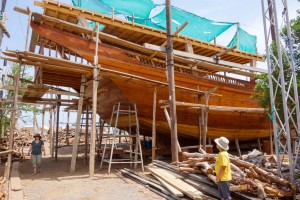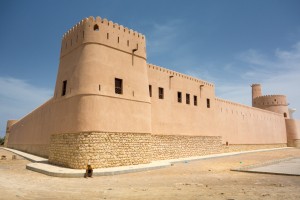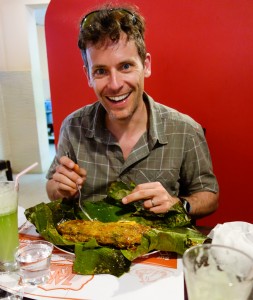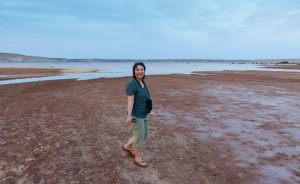Today for once we have the luxury of a slow start. Ryo sleeps like a log, so Skye and Sandra work on catching up on blog posts. We enjoy a nice breakfast on the terrace by the pool, check out of the hotel, and go off to visit Sur. We start with the dhow construction yard, as Sur was once the most important ship construction port in the middle east. Today they still hand-build the traditional boom dhows here, though there are only a couple of yards still in activity. Interestingly the boats are built without plans: the master builder does everything by eye from experience. All of the boat builders are from Kerala (South India) where hand-building boats is still a common activity. The dhow under construction is a gorgeous craft, and we wonder where the massive pieces of timber come from, given that there are no trees of that size in Oman.

We then visit the 200-year-old Bilad al Sur fort. It’s been recently renovated and is really beautiful with interestingly shaped towers, different from your usual round drum towers. Just as we arrive at the fort it is prayer time, so we hear the calling of the muezzin coming from all directions from the countless mosques in the city, it’s mesmerizing.

Next stop is the 300-year-old Sunaysilah Castle overlooking Sur. It’s a big square fort with a lone tree in its courtyard and a small square building in the middle, a Koranic school. Ryo’s getting fed up with forts, and it’s lunch time so we head to the popular Zaki restaurant.

We are quickly intercepted at the entrance because as there is a woman in our midst we have to use the side entrance and go up to the family room. The main room is for men only. Skye follows the waiter’s advice and opts for a local Sharee fish cooked in spices in a banana leaf. Sandra orders a very spicy fish curry and Ryo goes for sweet and sour chicken, all with garlic naan bread and salad washed down with a beer… if only! This is traditional Omani, so it’s dry, but we enjoy a lemon mint juice, it’s delicious!

Well fed, we leave Sur to Ras al Jinz, the most Eastern point of the Arabian Peninsula where the endangered green turtle lays its eggs. We are staying at the Turtle Reserve, a rather odd building with all the charm of a soviet edifice: there are hardly any windows to avoid disturbing the turtles with artificial lights. Baby turtles are apparently drawn to the light (moonlight on the sea), and after hatching would turn their backs on the water and head for our hotel if it wasn’t blacked out. We check in to a well-appointed if a bit gloomy room, so after our nap we don’t linger and decide to go check on the tented camp part of the complex. There is not much else we can do as the beach is off limits at this time of the day to avoid bothering the turtles.
So what to do? We had spotted a couple of lagoons on our way to the reserve, so we decide to hop in the car and drive back to check them out. We stop at the outskirts of a small village, on the edge of a mudflat where some plants are growing. Some shorebirds are wading in the mud and we do the same in an attempt to identify them in the failing light.

The mud is really sticky, the tide is coming in fast, and the several dead goat kids strewn about (presumably stuck in the mud and caught by the tide) encourage us to leave while we can! The sun sets and we return to the car after trying to clean our flip-flops in the tide: they look like giant brown clown shoes they are so caked with goopy chocolate-like dirt.

After washing our shoes in the room and clogging up the sink, the shower, and the toilet with sand and mud, we explore the small Turtle museum in the hotel and head to the buffet. At 8:30 all the guests gather in the lobby for the turtle watching excursion on the beach. This spot is the only place where turtles lay eggs every night of the year. Well, almost. The couple we met in the Wadi Shab said they weren’t lucky because the night they were there was turtle-free, but tonight the guides have spotted a lone turtle, we’re in luck! We huddle on the beach and our guide is in intense discussion with a spotter closer to the action: we have to wait until the turtle finishes digging and begins laying her eggs. Once they start popping out she can’t abort the mission even if she is disturbed, and has to finish laying and covering her eggs. Once covered she then digs a second “camouflage” hole next to the real one to fool foxes and other predators, cunning!

However the sand is too dry and her hole keeps caving in, so after digging for a while the turtle decides to give up and turn back to the sea. We are rushed over to see her before she reaches the waves and get to watch her shuffle her way over the 10 metres of beach to freedom. One of the guides shows us some turtle eggshells and also discovers a freshly hatched baby turtle heading the wrong way, attracted by the light made by our flashlights. We feel lucky to have had a glimpse of a turtle, and sorry for the poor female who, full of eggs, will have to try to lay again in a few days.